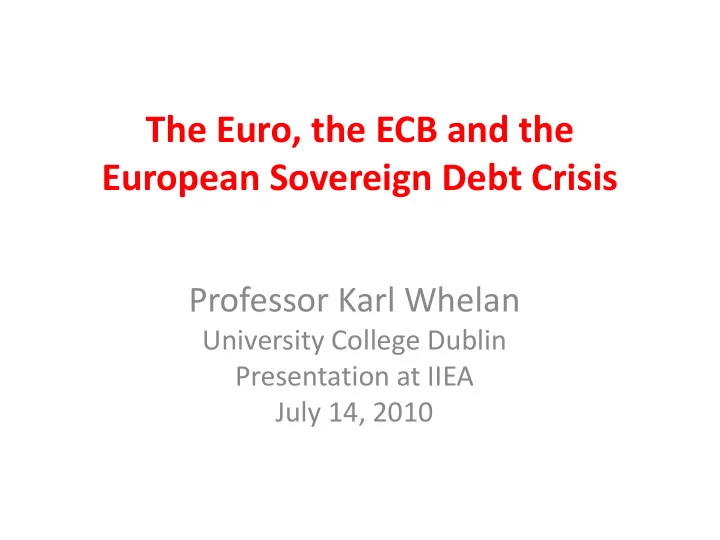

The Euro, the ECB and the European Sovereign Debt Crisis Professor Karl Whelan University College Dublin Presentation at IIEA July 14, 2010
Plan for Talk 1. What “the euro crisis” is and isn’t. 2. The Eurozone Stabilisation Fund. 3. The ECB’s sovereign bond program.
A Euro-Area Debt Crisis? Country\Area Deficit / GDP Ratio Debt / GDP Ratio Euro Area 6.6 88.5 UK 12.0 79.1 US 10.1 94.1 Greece 9.3 124.9 Ireland 11.7 77.3 Italy 5.3 118.2 Portugal 8.5 85.8 Spain 9.8 64.9
The Role of the Euro in the Crisis • Fiscal crisis often lead to devaluations: – Improves competitiveness of export sector. – Inflationary effects reduce value of debt relative to nominal tax revenues. • Greece, Spain, Portugal, Ireland all have serious competitiveness and debt problems. • But ECB is focused on price stability and these countries cannot devalue inside the euro: This is the sense in which this is “a euro crisis”.
An Existential Crisis for the Euro? • Probably not, for now at least: – Greece and others are still unlikely to choose to leave the euro. – Legal and technical difficulties and consequences of a banking system meltdown likely offset the usual positive effects. • And even if Greece left, so what? The Euro could carry on without them (Greece didn’t join until two years after initial launch.)
The Decline in the Value of the Euro • Factors weighing down the value of the euro: – Reconsideration of idea that European sovereign debt is risk free. – Worries about European banks. – Worries about growth given fiscal retrenchment. • Euro’s decline is a consequence of these factors rather than the “existential crisis” . • Of itself, euro devaluation is good news for an economic area with an unemployment rate over 10 percent and below-target inflation.
The Stabilisation Mechanism • Two reasons commonly cited for the May 9 th decision to introduce a contingency bailout fund of € 750 billion combined EU and IMF funds: – Financial stability – Saving the Euro • The second reason has been overhyped. The first is more key but is a political hot potato.
Exposure of European Banks to Greece, Portugal and Spain Exposure to: Greece Portugal Spain Total 193 240 832 France 78 45 211 Germany 45 47 238
Financial Stability Rationale • As with subprime MBS, markets are unsure of exposure of individual banks to sovereign debt: EU stress tests an attempt to deal with this problem. • Interbank markets have tightened up and bank bond issuance has been minimal over past few months. • Stabilisation Fund can be viewed as an attempt to “cut the problem off at the pass” by eliminating (or at least managing) sovereign defaults.
Saving the Euro? • Common idea that a sovereign default would be “the end of the euro” so the Stabilisation Fund is “saving the euro.” • But current developments may have potentially negative long-term consequences for euro: – EU (and euro) gets blamed for unpopular fiscal adjustments. – EU monitoring seen as undermining national sovereignty. – Repeated bailouts may be unpopular with Germany. This is may be the real long-run threat to the euro.
The ECB’s Sovereign Bond Purchases • The ECB has come under political pressure to intervene in the sovereign bond crisis. Its reputation for independence has been undermined by decisions: – To allow Greek debt to count as eligible collateral no matter what ratings it has. This happened despite promises of “no special treatment” for any country. – To buy government bonds on secondary market. This clearly breaks the spirit if not the letter of the ECB’s “no monetary financing” clause.
Many Unknowns about ECB Program • The ECB’s program is lacks any transparency. We don’t know about the program: – The composition of the debt securities the ECB is buying. – The criteria being used to select bonds to purchase. – The ECB’s bond purchase strategy during periods of primary issuance. – How long the program is going to last and how much may be spent. • Bond purchases tailing off: € 16 billion in first week, only € 1 billion last week. Is the program finished? Or perhaps just finished for now?
The Current Situation • ECB bond purchase program looking more and more like a temporary stopgap while the Stabilisation Mechanism funds were put in place. • Borrowing situation has worsened since May 9: – Irish ten year bond spread over bunds at 276 basis points (not far off early May levels.) – Portuguese spreads at 303 basis points. • Worries that bank funding problems highlighted in stress tests will spill over to sovereigns (a major issue for Ireland). • Likelihood of EU-IMF fund being called on is increasing.
Recommend
More recommend